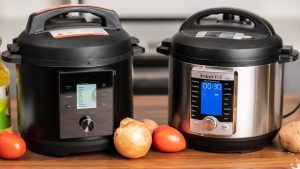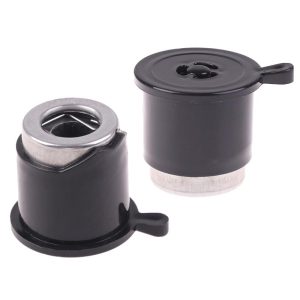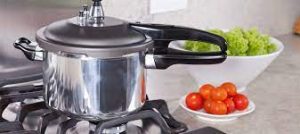Learn About The Functions Of A Pressure Cooker!

Denis Papi, a French physicist, presented the prototype of the pressure cooker to the Royal Society of London in 1681 (created 79 but presented 81). As the pressure cooker we know today, his invention elevated the boiling point of water and significantly reduced cooking periods.
The ordinary public, on the other hand, would have to wait almost 250 years before they could get their hands on a pressure cooker for home use. There were no electric pressure cookers back then, so everything was cooked on the stovetop. While stovetop pressure cookers are still in use, the introduction of electric pressure cookers changed the game.
I decided to do some study on the subject, which I discovered.
What is the operation of an electric pressure cooker? As opposed to stovetop pressure cookers, electric pressure cookers have a heating element that, when activated, heats the contents of the sealed container. An electric pressure cooker requires nearly no manual changes because it can automatically regulate temperature and pressure using sensors. When the appropriate temperature limits are reached, the heating element goes into standby mode as long as the values remain steady. The heating element is engaged until the levels are restored if they change.
Both electric and traditional stovetop pressure cookers operate on the same concept, which is steam pressure. Essentially, the pressure cooker performs a simple yet effective technique.
The pressure cooker’s container is first filled with liquids and sealed tight, after which the liquids are brought to a boil, producing steam.
Because the container is sealed tight, except for a little valve that gradually releases a small amount of steam, the trapped steam inside the container builds up pressure. This has two consequences:
- Water’s boiling point rises as pressure rises: Water boils at 212 degrees Fahrenheit at sea level and evaporates at higher temperatures. As a result, you are limited to cooking at 212F – yet because of the increased pressure of the pressure cooker, the boiling temperature of the water inside the container can reach 250F.
- Liquids are forced into the food due to the pressure: The increased pressure also causes wet heat to be forced into the food. As a result, the meat becomes extra tender, and the cooking time is reduced.
Because of the increased pressure, the pressure cooker may significantly reduce cooking times. As previously indicated, both electric and stovetop pressure cookers use this one principle.

What Is the Difference Between an Electric Pressure Cooker and a Stovetop Pressure Cooker?
So, since they both operate on the same premise, what distinguishes them?
Electric pressure cookers are more complex in design than ordinary stovetop pressure cookers, but they are considerably easier. Still, the electric pressure cooker does not always outperform the traditional stovetop cooker — they each have their strengths and weaknesses.
Electric pressure cookers of the third generation are provided with their heat source. Traditional pressure cookers are not. They are heated on the stove, giving rise to “stovetop pressure cookers.”
Electric pressure cookers are all about automated systems, requiring very little care and maintenance. The electric pressure cooker automatically adjusts when pressure or temperature levels drop until appropriate values are restored. Sensors detect signals that show whether or not the levels are steady. The pressure cooker then determines whether or not to operate the heating element.
The ability to run the heating element regularly equals less energy use.
The electric pressure cooker, with built-in sensors that regulate levels back and forth, appears futuristic compared to the stovetop pressure cooker, where the user must regulate levels manually.
Regular cookers include a gauge that displays the temperature and pressure levels. When the levels are not balanced, the temperature on the stove must be manually adjusted.
Because the electric pressure cooker is so automatic, mastering it is simpler than mastering a typical stovetop cooker.
Among the most commonly installed pressure cookers is the Instant Pot. If you showed Denis Papin, the inventor of the steam digester in 1679, the Instant Pot, he would most likely accuse you of witchcraft.
Many electric pressure cookers (multicookers) such as the Instant Pot can do more than just pressure cooking. They also have capabilities that allow them to be used as slow cookers, rice cookers, yogurt makers, and other appliances with the touch of a button.
Are Electric Pressure Cookers Safe?
Even though pressure cookers are extremely safe to use these days, the concerns about pressure cooking remain. The idea of keeping the pressure inside a heated vessel is risky – but pressure cookers are now fail-safe.
Manufacturers have invested time and money in designing safety features to ensure that no one is hurt while using their products. Modern pressure cookers are outfitted with many types of safety measures.
Pressure cookers may now discharge excess pressure thanks to backup vents and overpressure valves. Normally, pressure levels should remain consistent, but if the pressure cooker does not cease cooking once maximum pressure is reached, having a release for excess pressure is highly convenient. The overpressure plug can be used if the standard release valve becomes clogged during the cooking process.
Finally, the sealing ring inside the lid stops the lid from blasting through the roof when opened, preventing the user from opening the lid until the pressure has dropped.
When all of these features are working properly, using an electric pressure cooker can be very safe. It is critical to double-check the features and components to ensure proper function.

Are Electric Pressure Cookers Better Than Stovetop PCs?
Pressure cookers are commended for their ability to prepare meals swiftly. While this is true for both pressure cookers, testing has shown that the classic stovetop cooker is somewhat faster than the electric pressure cooker.
The stove generates more heat than the heating element in electric pressure cookers. The disadvantage of using the stove as a heat source is that it necessitates significantly more supervision. To maintain pressure levels consistently, the user must adjust the temperature.
Because you have to attend to the appliance so frequently, it is less convenient than the electric version. In truth, the electric pressure cooker can be left unattended, which I do not advocate, and I strongly advise against leaving your house.
I normally start cooking, then perform various duties around the house while occasionally checking on the pressure cooker.
Another significant advantage of utilizing an electric pressure cooker is its adaptability. Frequently, you’ll encounter an electric pressure cooker with a slew of buttons, each of which offers a different manner of cooking. An electric pressure cooker is frequently used as a rice bowl or slow cooker.
Because not all parts of the electric pressure cooker can be submerged in water, cleaning it might be time-consuming. Because stovetop pressure cookers do not have any electric components, they can be submerged in water without causing problems.

Are Electric Pressure Cookers Energy-Efficient?
The cost of running an appliance is proportional to how long it takes to complete a cycle on the appliance. If you use the appliance for several hours every day, you may expect it to cost you some money. Consequently, it is advantageous to employ quick cooking methods. When it comes to pressure cookers, we know they are much faster than many other ways, in some cases up to 70% faster.
While testing has shown that electric pressure cookers are not as fast as stovetop pressure cookers, they are fast. Another factor to consider is the electric pressure cooker’s capacity to activate the heating element only when necessary. When cooking in an Instant Pot for an extended time, the heating element is only activated for about 40% of the time.
Pressure cookers also use less water than boiling on the stovetop, making them an even more environmentally friendly option.
How Do Electric Pressure Cookers Release Pressure?
When the pressure cooker is cooking, the user must depressurize it before opening the cover. On electric pressure cookers, there are two ways to accomplish this.
- Natural release: When you’re finished cooking, leave the switch in the Sealed position, and the pressure gently releases. As the temperature drops, the pressure gradually dissipates. When it is fully released, the float valve drops, and the lid opens.
- Flip the switch to Venting/Quick Release when you’re done cooking. This opens the release valve, causing pressure to drop as steam bursts are driven out of the container.
When cooking meals that you don’t want to overcook, the quick release comes in helpful because it releases pressure instantly, whereas the natural release takes a long time. Using the natural release when cooking food that produces foam inside the pot is recommended to prevent foam from bursting through the release plug.
Keep in mind that anything within the container will continue to cook even after the pressure cooker has released its pressure. If not well planned, naturally releasing pressure can result in overcooking.











